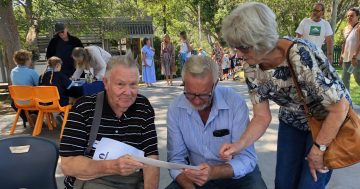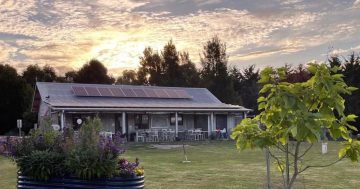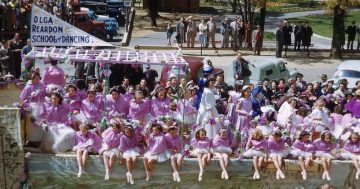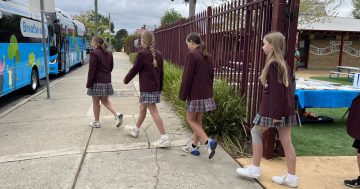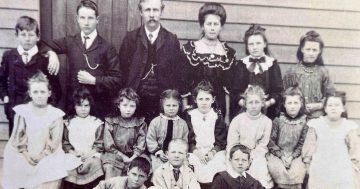
Murrumbateman school students in 1909, with teachers Mr and Mrs Fairley. Photo: National Library of Australia, Mrs B Carney collection.
What would the children who attended the original Murrumbateman school make of the modern, shiny new school to be complete by 2023 next door to their old schoolhouse?
Like the current generation, the parents of the Murrumbateman community in 1869 had to lobby hard to get their school. It began as a two-room, timber slab walled building with a bark roof paid for by the parents and one of the rooms was the teacher accommodation.
This was replaced in 1872 with the well-proportioned brick building still standing today and used as the village library.
The teacher Mr Jobson had to wait until 1875 to get a three-room brick teacher’s residence next to the old schoolroom. The original bark roofed kitchen became his kitchen and washroom.
The average attendance in the first half of 1872 was 25.1 students. There were 36 pupils on the roll by 1874.
Surnames were the same as those on that original letter to the Council of Education in 1869 – Webster, Armstrong, Carter, Lucas, Greig, Johns, Hollingsworth, Marshall and Vallance – names that still resonate in the district today.
As a farming community, pupils walked or rode to school and mostly went home to chores, hard work and family responsibilities.
Jean Armstrong started school in 1917 when she was seven. Her father Thomas had been a student in 1886, just a year ahead of another young fellow Walter Merriman.
Jean walked to school crossing two creeks which sometimes flooded. She loved the schoolyard.
“The pupils’ gardens, securely netted against rabbits, are models of neatness and systematic toil,” reported the School Inspector.
Trees planted in 1888 now provided shade and parent pressure led to a proper floor in the weather shed to stop children coming home filthy. Young Jean would have enjoyed the well-developed garden with its shrubs and flower beds, all nicely fenced.
School concerts involved much rehearsal and costumes lovingly made by mothers. Jean and sister Norma, with ‘rag ’curls and beautiful angel wings of cleverly folded paper, almost managed their duet until Jean froze with stage fright.
Mother was not impressed but the end-of-year break-up party was a success.
“The children in fancy dress, led off with a grand march, followed by quadrilles and later danced Sir Roger de Coverley very gracefully. Various choruses, recitations, and dialogues were given by them, excellent enunciation being marked.”
School picnics were a highlight with skipping, three-legged and sack races, high jump – boys only of course- a lucky peanut scramble and excellent picnic lunch. The Queen’s Birthday celebrations in 1900 concluded with cheers for the Queen, Baden Powell and Mafeking and for the teachers Mr and Mrs Dyce. The bonfire and Kruger effigy were not lit due to rain.
Empire Day in 1911, celebrated with addresses, recitations, and patriotic songs, included prizes for Good Conduct – Alf Martin, Most Progress – Mern Smith, Best Attendance – Lance Vallance and Stanley Greig divided. A dumbbell display by the children earned them an afternoon tea followed by a well-organised tennis match.
Popular teacher Mr Fairley was sadly farewelled in 1909 having founded the school library and museum and the children’s tennis club, “into which he infused an energy which was truly marvellous”.
No doubt he would have been disappointed when the school was closed in 1973 but honoured to know the new subdivision is named after him.
For excitement though, it would be hard to beat Bertie Armstrong’s reaction at 11 o’clock, 11 July 1918 to the sound of the entourage of the Governor-General, Sir Munro Ferguson on his way to Canberra.
“We raced down to the road, climbed the two railed fence to cheer the cars going past.”
The cars stopped and the Governor-General came back.
“He couldn’t go past cheering children,” he said and promptly gave the teacher 7 shillings and sixpence to buy lollies for the school.
Will the new school eventually take over the old schoolyard? If so, the buildings and the voices of the parents and students of those more than 100 years, 1869 to 1973, who pioneered education in Murrumbateman should be preserved.
Judith Davidson is a local historian, uncovering the stories of the Yass Shire.






